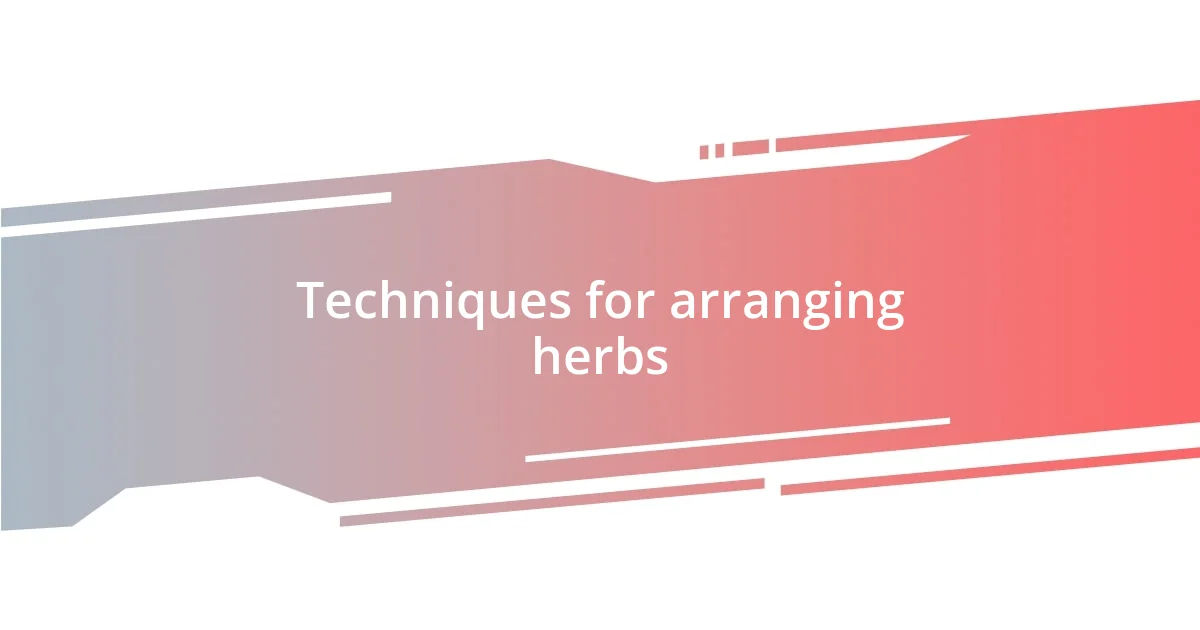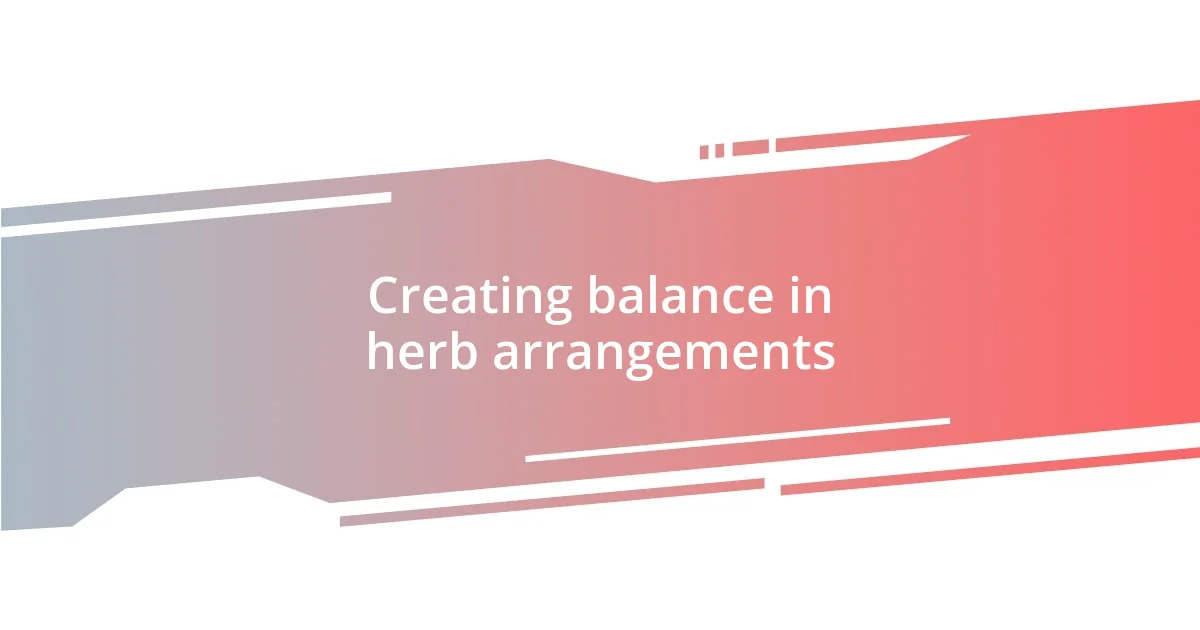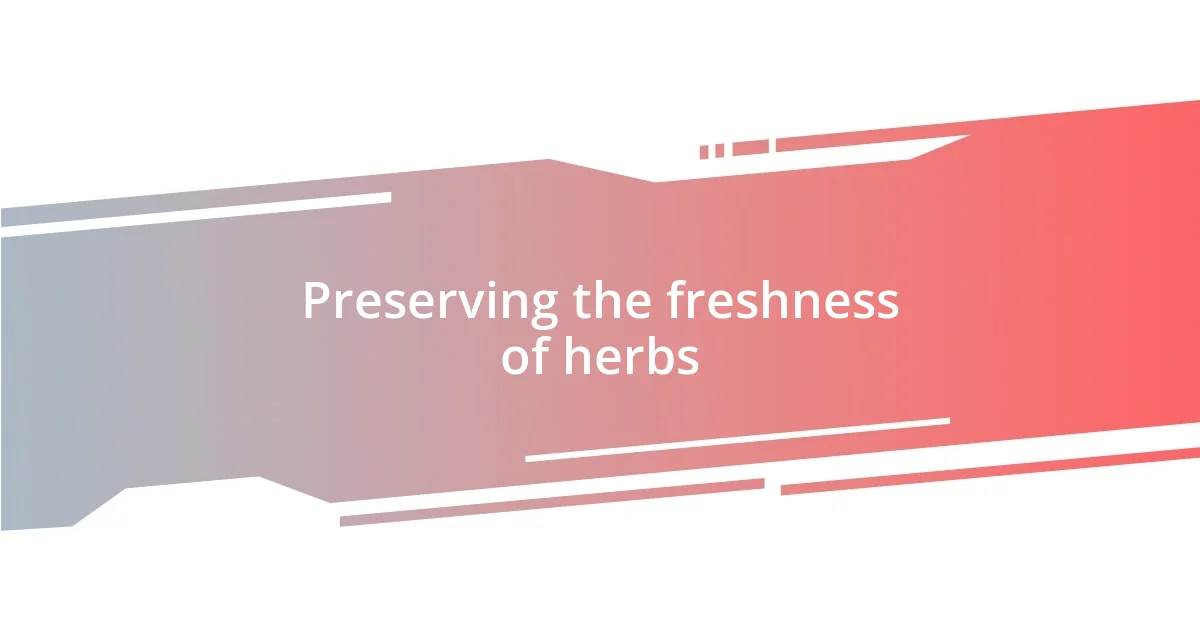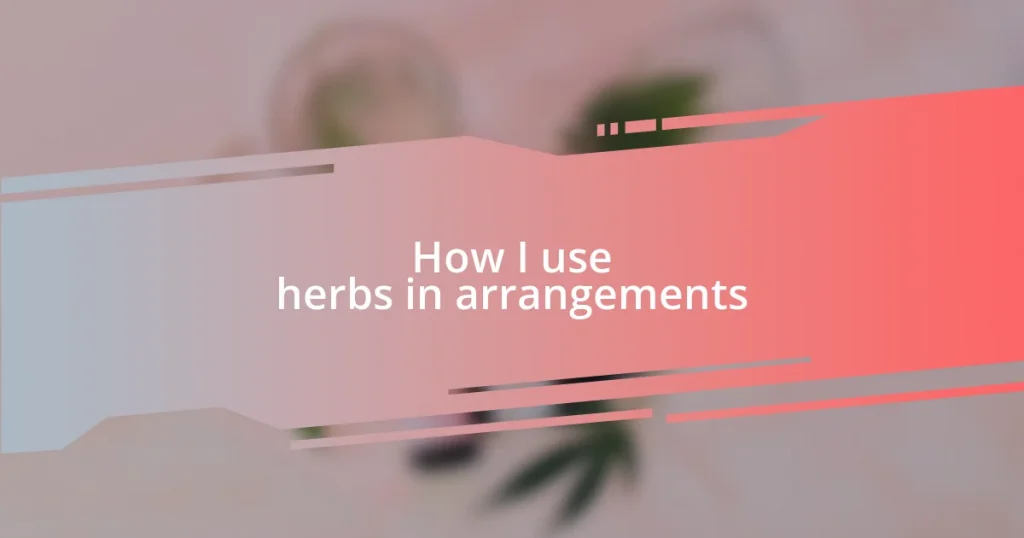Key takeaways:
- Herbs enhance floral arrangements by adding texture, fragrance, and emotional resonance, fostering a deep connection with nature.
- Freshness is crucial; proper techniques like harvesting, washing, and cutting herbs maximize their vibrancy and prolong their lifespan.
- Creating balance in arrangements involves thoughtful use of proportion, texture, and color, as well as varying heights for visual interest and flow.

Understanding the role of herbs
Herbs play a transformative role in floral arrangements. They add texture, fragrance, and depth, making a bouquet not just a visual experience but an olfactory one as well. I still remember the first time I used rosemary in a centerpiece; the moment the scent enveloped the room, I felt an instant connection with nature.
When I combine herbs like basil or mint with flowers, I often think about how each one seems to tell a story. For instance, the bright green of mint enhances the vibrancy of other blooms, evoking feelings of freshness and vitality. Have you ever considered how the essence of herbs can transport you back to treasured memories, like a summer dinner party where your grandmother used fresh herbs from her garden? That aromatic nostalgia adds a heartfelt touch to any arrangement.
Using herbs isn’t solely about aesthetics; it’s about evoking emotions and creating atmospheres. I frequently experiment with different herbs, observing how each one shifts the mood of my arrangements. For instance, a sprig of lavender can add a calming feel, while the spice of thyme brings warmth and comfort. What role do you think scents play in your daily experiences? In my view, they can profoundly shape the emotions we associate with any given moment.

Preparing herbs for use
When preparing herbs for use in arrangements, I always prioritize freshness. The scent and vibrancy diminish quickly after harvesting, so I like to pick herbs shortly before I start working. Whether it’s snipping a few sprigs of thyme or cutting some basil, the experience feels like a mini-adventure each time. Have you ever noticed how the act of harvesting can create a deeper connection with your materials?
After harvesting, I gently wash the herbs to remove any dirt or unwanted critters. I can’t stress enough how important this step is—clean herbs not only look better but also ensure that any arrangement is safe and pleasant to be around. Once washed, I usually wrap the stems in a damp paper towel, which helps retain moisture and prolongs their life in the arrangement. It feels rewarding to invest that little bit of extra care.
The way I cut the stems is just as crucial; I often make a diagonal cut to maximize water absorption. This method has become second nature for me. I remember the first time I didn’t cut the stems properly, and the herbs wilted within hours. Since then, I’ve made it a habit to pay attention to these small details. What little practices do you incorporate into your creative processes? In my experience, they can truly make a positive impact.
| Preparation Step | Reason/Benefit |
|---|---|
| Harvesting Fresh Herbs | Ensures maximum fragrance and vibrancy |
| Washing Herbs | Removes dirt and keeps arrangements safe |
| Wrapping in Damp Towels | Helps maintain moisture and prolongs freshness |
| Diagonal Stem Cuts | Increases water absorption, preventing wilting |

Techniques for arranging herbs
Arranging herbs is an art that combines technique with creativity. I love experimenting with various placement strategies—whether it’s creating a focal point using taller herb stems or layering shorter herbs to provide a soft base. I vividly recall the time I arranged a spring bouquet with fresh dill. The delicate fronds added a whimsical touch, almost like a visual whisper that drew the eye in. The whole process felt intuitive and meditative, as if each herb knew its place in the arrangement.
Here are some techniques I find particularly effective:
- Layering: Start with a sturdy base and build upwards for depth.
- Grouping: Place similar herbs together for a cohesive look while contrasting them with vibrant flowers for visual interest.
- Dramatic Heights: Use tall herbs like parsley to create vertical lines, adding elegance and sophistication.
- Texture Variation: Combine smooth-leaved herbs with bumpy or feathery ones to create visual dynamics.
- Fragrance Placement: Position aromatic herbs near the front for an enhanced sensory experience.
Each technique helps in crafting a unique arrangement that resonates not only visually but also emotionally. I often reflect on how these subtle decisions can affect the mood in a space, making each arrangement feel distinctly personal.

Creating balance in herb arrangements
Creating balance in herb arrangements is essential for an aesthetically pleasing and harmonious display. Personally, I think of balance in terms of proportion and contrast. One time, while working on a dinner centerpiece, I paired bold, sturdy rosemary with delicate chives. The visual appeal was striking, and the contrasting textures seemed to dance around each other, creating a joyful balance. Have you ever felt that moment when an arrangement just clicks, and everything feels right?
Another key to balance lies in the color palette. I often choose herbs with complementary hues to ensure that the arrangement flows seamlessly. A vivid basil against the soft greens of mint can create a sense of unity, while introducing a splash of edible flowers offers a delightful pop without overwhelming the senses. I remember an arrangement that not only looked good but also smelled incredible—a reminder that balancing visuals and scents can elevate the entire experience. How do you approach color when you arrange your herbs?
Lastly, I believe that varying heights within the arrangement creates a sense of movement and flow. When I create taller focal points, like vibrant lavender, I make sure to anchor the design with lower-growing thyme or oregano in front. This leads the eye through the arrangement, engaging the viewer and creating a dynamic balance. Reflecting on these choices helps me appreciate the level of artistry involved in simply arranging herbs. What heights do you explore in your artistic process? Each choice can turn an arrangement into a story waiting to be told.

Preserving the freshness of herbs
Preserving the freshness of herbs is crucial for both aesthetic and aromatic quality in my arrangements. I often find that keeping herbs hydrated is key. A simple trick I use is placing the cut ends of stems in water, almost like a refreshing sip for them. It’s amazing how quickly they perk up, reminding me of how much care these delicate plants require.
Sometimes, I also prefer to wrap the herb stems in a damp paper towel before putting them in a plastic bag in the fridge. This technique keeps the moisture locked in, giving them an extended life. I vividly remember trying this with mint, and it was a game changer. The next time I pulled it out, it was still vibrant and fragrant, comparable to when I first bought it.
Additionally, I make a habit of trimming the stems each time I use them. It’s like giving them a fresh start! This practice has not only prolonged their freshness but has also become a comforting ritual for me. Have you ever noticed how rewarding it feels when you nurture your herbs, and in return, they elevate your arrangements? I find joy in this reciprocal relationship, as it enriches the entire creative process.















